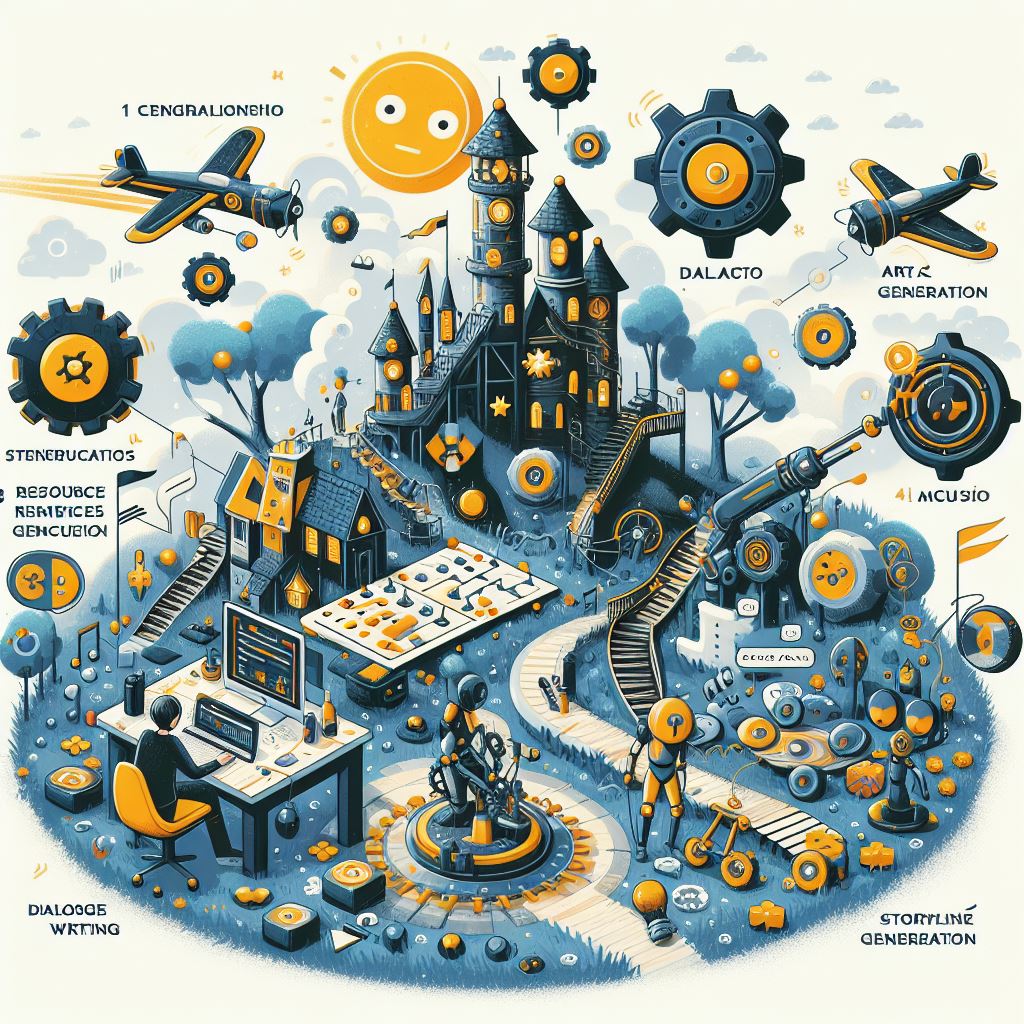In the dynamic landscape of the global video game market, where innovation and technology converge to shape the future of gaming, the role of artificial intelligence (AI) stands out as a game-changer. With the market projected to surge to an astounding $180 billion by 2024, AI has emerged as a pivotal force propelling this exponential growth. An impressive 61% of surveyed game developers acknowledge harnessing AI to craft player-centric elements within video games, showcasing the industry’s reliance on this transformative technology. The symbiotic relationship between advanced AI and player engagement is evident, as research indicates a significant 29% increase in engagement when AI is seamlessly integrated into gaming experiences. Moreover, a staggering 87% of video game developers anticipate AI’s dominance over the industry in the next decade, underscoring its profound impact. Currently, 46% of game developers are actively integrating AI into their development processes, streamlining workflows and catalyzing a 50% reduction in the time required to bring a video game to fruition. However, this seismic shift towards AI integration is not without its challenges, as evidenced by the 33% of gamers who admitted that AI made their gaming experiences more challenging. As we navigate this era of unprecedented innovation, exploring the intricate interplay between AI, risk, and security in the video game realm becomes imperative for developers, enthusiasts, and industry stakeholders alike.
Source: https://zipdo.co/statistics/ai-in-video-games/

Generative AI is being used mainly in the following use cases:
- Boosting the Development Process by automating some resource generation (like art generators or music and effect generation).
- Dialogue writing and storyline generation.
- Enhancing NPCs behavior.
- Simplifying the testing and validation of the product with AI playing the game.
Prompt Injection
One of the main risks related to Generative AI, particularly with LLM (Large Language Models) is related to the prompt injection attacks. In fact in the OWASP LLM Top 10 it is rated as number one risk: https://owasp.org/www-project-top-10-for-large-language-model-applications/assets/PDF/OWASP-Top-10-for-LLMs-2023-v05.pdf
During a prompt injection attack the adversary manipulates or inserts malicious input (often in the form of commands or data) into a system’s prompts or input fields.
This can happen in applications used to create content (Dialogue writing) in which case the adversary is an internal employee that could use access to the tool that generates dialogues or stories to execute the attack internally.
The other scenario which is more impactful is the use of LLMs to enhance NPCs behavior. In this scenario if the developer lets the player to chat with the NPCs there is a big chance that the player could execute the attack. This is way more impactful because the attack would be “public” as any player could achieve that.
The consequences of prompt injection can be severe, potentially leading to unauthorized access, data breaches, system compromise, or the execution of unintended commands. It will depend mainly on the capabilities of the LLM and what can the software do or have access to.
Mitigating the risk of prompt injection is really tricky, because when the feature requires on natural language processing, it is hard to validate whether the content in the paragraph sent is malicious or not. Mitigations available so far are related to input length limitation, reduced scope of responses (some use cases makes this impossible) or reduced access to the model to sensitive data in order to make the attack less impactful.
Insecure Output Handling
In the realm of generative AI and game development, Insecure Output Handling refers to a vulnerability where the system fails to appropriately validate and manage the outputs generated by the AI models. This inadequacy can lead to the acceptance and integration of unverified content into the game environment, risking the introduction of malicious, inappropriate, or low-quality elements. In essence, Insecure Output Handling poses a threat by allowing unfiltered or uncontrolled AI-generated content to directly influence and impact various aspects of the gaming experience, potentially leading to security breaches, privacy concerns, and a degraded user experience.
The risk of introduction of inappropriate or low-quality elements in the game industry is huge. In both cases the reputational damage would be major, and it would make the company lose a major amount of players, dealing to high finantial loses.
Perhaps even more alarming is the prospect of inappropriate elements making their way into the public domain. Such an occurrence could not only result in significant financial losses for the company but also trigger legal complications. The potential fallout from the exposure of inappropriate content extends beyond mere monetary considerations; it poses a dual threat by jeopardizing both the company’s financial standing and potentially entangling it in legal disputes. In the fast-evolving landscape of the gaming industry, safeguarding against the inadvertent dissemination of objectionable material becomes paramount, as the repercussions extend beyond financial implications to encompass legal ramifications, brand integrity, and overall stakeholder trust.
In this case the main mitigation would be to validate the output, which is not trivial in cases where the Gen AI tool was used to automate a process. Here the issue is that the best way to validate the output is by setting in the process people that would check the content created. That might be possible in internal tools, but in cases like real-time chat between NPCs and players it is impossible.
An alternative would be to add another layer of Gen AI tools that would validate the content before it is shown to the user (e.g. the images generated being sent to another AI that would explain what is the content of the image and let you know if it is appropriate for the desired content). As it is said “If AI did not solve your problem, it is because you didn’t use enough AI”.
Training Data Poisioning
Data Poisoning attacks emerged with the rise of Machine Learning models in the late 20th century, specifically during the training phase. In machine learning, models learn and improve through exposure to data. However, Data Poisoning intervenes during this crucial training phase, deliberately distorting or manipulating the training data, thereby compromising the accuracy of the predictive model. An illustrative example is the attack on Google’s anti-spam system from 2017 to 2018. In this case, the attackers corrupted the input/label pairs used to train the anti-spam model, leading it to misclassify spam messages as non-spam, thereby allowing spammers to evade detection.
What makes Data Poisoning particularly concerning is its increasing accessibility. Previously considered complex and resource-intensive, new techniques, such as the TrojanNet backdoor, have made these attacks feasible even for smaller hackers. TrojanNet employs a neural network to detect patches, enabling manipulation without requiring access to the original model. Once a model is trained with poisoned data, correcting it becomes a formidable challenge, often necessitating expensive and time-consuming retraining.
The implications of Data Poisoning in the case of the gaming industry is not as severe as it could be in cases like integrations into critical aspects of society, such as healthcare, transportation, and criminal investigations. Even when in our cases the consequences could lead to some kind of “hack” in a game, it is hard to pull and it is really hard to predict the effectiveness of the attack as training data not always makes a 1:1 to the model behavior (in Generative AI at least).
Despite the reduced risks (compared to other industries), it should be addressed properly. In contrast to the previous risks, the company that uses in-house training data has the possibility to prevent or mitigate it. Techniques include rigorous examination of databases before incorporation into model training, using statistical methods and regression tests for anomaly detection, employing cloud tools like Azure Monitor or Amazon SageMaker to monitor model performance during training, and maintaining the confidentiality of model operating information to prevent attackers from acquiring prior knowledge during the training phase. As the importance of AI and machine learning continues to grow, protecting against Data Poisoning becomes imperative for maintaining the integrity and effectiveness of these systems.
Data Leakage
The risk of data leakage particularly in Large Language Model (LLM) solutions within the video game development introduces a critical challenge, demanding a nuanced understanding of potential vulnerabilities and the implementation of proactive measures for mitigation. In video game scenarios, data leakage can occur when an LLM inadvertently reveals sensitive information, proprietary algorithms, or other confidential details through its responses.
Users interacting with LLM-driven game applications must be aware of the risks associated with inputting sensitive data, particularly in the context of dialogue generation or storyline creation. Conversely, game developers employing LLMs should prioritize robust data sanitization and scrubbing validation to prevent user data from infiltrating the training model data, especially when automating resource generation for art and music. Additionally, establishing transparent Terms of User policies is crucial to inform players about data processing practices.
To address common vulnerabilities in video game applications, implementing effective data sanitization techniques, stringent input validation, and ongoing supply chain risk mitigation are essential. Dedicated LLMs for benchmarking, reinforcement learning techniques, and the incorporation of red team exercises or vulnerability scanning during testing phases enhance the overall resilience of the gaming system against potential data leakage threats, safeguarding the integrity and security of the gaming experience.
Copyright problems
Another issue not related to security about this technology is that GenAI grew fast, faster than anything we’ve seen so far. From one year to the other capabilities of these technologies were potenciated to the skies. But legislation did not go as fast as this technologies, so there are really a lot of problems in different situations and not a clear way to solve it:
- Infringment of copyright rights. AI can be used to create storylines, quests, music, and other game assets. This again raises questions about intellectual and copyright issues, especially on the data used for training and even the output. For instance, assets from generative AI may inadvertently resemble copyrighted material, which could lead to legal issues.
Steam, a gaming platform, has been rejecting games that use AI-generated assets without clear IP rights. Steam’s creator stated that developers must prove ownership of the IP used to train the AI before games with AI-generated content can be released on the platform.
- If a developer writes a story using AI, would he be able to claim copyright over the content? Intuition states that it should be as the prompt was created by the developer. But because of the laws being outdated this might not happen. Check the following quote of a report on GenAI and Copyright Law:
The U.S. Constitution authorizes Congress to “secur[e] for limited Times to Authors . . . the exclusive Right to their . . . Writings.” Based on this authority, the Copyright Act affords copyright protection to “original works of authorship.” Although the Constitution and Copyright Act do not explicitly define who (or what) may be an “author,” the U.S. Copyright Office recognizes copyright only in works “created by a human being.” Courts have likewise declined to extend copyright protection to nonhuman authors, holding that a monkey who took a series of photos lacked standing to sue under the Copyright Act; that some human creativity was required to copyright a book purportedly inspired by celestial beings; and that a living garden could not be copyrighted as it lacked a human author."
Source: https://crsreports.congress.gov/product/pdf/LSB/LSB10922

Conclusion
In conclusion, the integration of Generative AI technologies in video game development heralds a new era of innovation, revolutionizing creative processes and enhancing player experiences. However, this rapid evolution introduces significant security challenges. Prompt injection, insecure output handling, training data poisoning, and data leakage stand as formidable risks, each demanding meticulous attention to safeguard the integrity and security of gaming environments.
As the gaming industry continues to embrace these transformative technologies, it is imperative for developers and stakeholders to prioritize robust security measures. Proactive validation, stringent data sanitization, and ongoing monitoring are crucial components of a comprehensive strategy to mitigate risks associated with Generative AI. If you are considering the adoption of these technologies and seek expert guidance to fortify your gaming systems, we invite you to reach out. Our team is dedicated to providing tailored assessments and solutions, ensuring a secure and resilient future for the evolving landscape of video game development.


